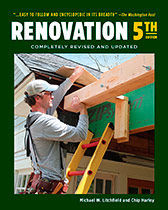Podcast 204: Patio Doors, Plant Spaces, and a Too-Tight Window
Replacing huge patio doors, creating an indoor plant space, and getting rid of a masonry chimney.
Follow the Fine Homebuilding Podcast on your favorite app. Subscribe now and don’t miss an episode:
 |
 |
The regular crew hears from listeners about galvanic corrosion, eating honey that’s 160 years old, and what the VHB in VHB tape really stands for. Then they take listener questions about replacing a monster sliding patio door, getting a too tight window to fit and removing a two-story masonry chimney from a foursquare.
Listener Feedback:
Listener feedback #1
Barbara from Georgia writes, Can I just say you definitely can’t put aluminum gutters on a house with a copper roof? You can’t even let aluminum touch pressure treated wood because the copper in the chemical treatment will corrode aluminum so aggressively. I have some aluminum tubing as part of my outdoor shower mounted between two pressure treated posts and I used special PVC flanges to keep it from touching the wood. And I have some aluminum towel hooks on the outdoor shower too, screwed on with stainless steel screws. I cut little pieces of vinyl flashing to put behind them to be sure the aluminum wouldn’t be eaten away even though I painted the post first.
Related links:
Listener feedback #2

Related links:
- Oldest bottle of wine remains sealed since the 4th century
- Book: The Billionaire’s Vinegar: The Mystery of the World’s Most Expensive Bottle of Wine
Listener feedback #3
Ryan writes, I got a serious laugh when you guys were talking about VHB tape in the last episode. We all think it stands for “Very High Bond” and the 3M website says it will “permanently adhere one substrate to another”. I bet the Engineers trying to remove it during testing called it a “Vehemously Monstrous Bitch”, said it’ll give you “Very High Blood pressure” in the process, and overall causes “Violent Hatred and Berating” for those that designed it. To be politically correct 3M had to settle on “Very High Bond” though…
Keep up the good work, it’s been fun to hear you guys mix up the podcast crew lately and I really like hearing from Justin once in a while.
Related links:
Listener feedback #4
Bryan of Pioneer Builders writes, Hi All, Wanted to let you know that Season 2 of Abstract the Art of Design is now streaming on Netflix. Kiley mentioned this program in a previous episode. I actually discovered this show because of BD+C (Building Design+Construction) a couple of years ago.
Thanks for what you guys are doing. Appreciate it.
Editors’ give feedback on their recent Summit experience:
Slideshow presentations, videos, articles, and more from the 2019 Fine Homebuilding Summit.
Question 1: Does it make more sense to repair or to replace my damaged patio door?
Bert in St. Louis writes, Hi there, I’ve been listening to your podcast for the last few months now trying to learn about how to improve the efficiency of my 1954 slab-on-grade mid-century ranch. The central living/dining/kitchen area of the house has beautiful (single pane) floor-to-ceiling windows, including 2 10-foot x 80 inch sliding patio doors. Well, yesterday my lawn guy had a little ‘oops’ on the back patio and shattered the fixed portion of one of those sliding patio doors, a 1/4 inch thick 75×60 inch piece of glass. He is taking responsibility and sending a window company he’s worked with in the past out to figure out what we can do. While I’m sure it’s possible to simply replace the pane, it seems like the cost of doing so is likely to approach the cost of a replacement with a far more energy-efficient option, and any repair is likely to come out looking a bit wonky with paint colors that don’t exactly match and slightly different glass on the fixed and sliding portions of the door. The door itself also doesn’t slide easily or lock securely, so there are many reasons for an upgrade.
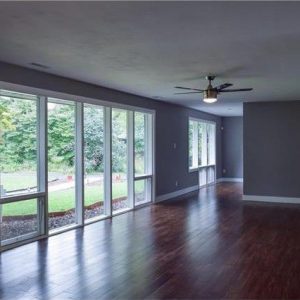 |
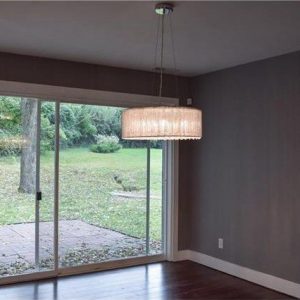 |
 |
At this opening size, I’m curious to know how different options might compare, including French doors with sidelights, similar sized sliding doors, or some other arrangement. The two large doors were a huge selling feature of the house, so I’m not sure whether we should press to have both replaced at once. They are visually separated from each other, but it does feel nice to us that they currently match. Thanks for your podcast!
Related links:
Question 2: What’s the easiest way to fix a rough opening that is too small for a new window?
Cam writes, Hi all, I’ve subscribed to the magazine for years now and only found the podcast last year. I love it. The interplay of the various hosts is great and the substantive stuff you discuss, even when it isn’t air-sealing, is well done.

What are my options? Jamming it in seems like a humid day away from a big problem, and I don’t have a great idea of how to efficiently and evenly remove stock from the inside of rough opening. Is deconstructing the opening and rebuilding it a little larger my only hope? Is there a shaver-downer tool I haven’t yet met?
Related links:
Question 3: What details should I include to make a bathroom/greenhouse moisture-proof?
Aaron from Pittsburgh writes, Greetings podcast, I have (another) odd project that you might find interesting. My wife is in love with plants, and in lieu of adding a full blown conservatory to our reno plans I want to make our master bathroom into a pseudo-greenhouse.
The bathroom has three large windows and two large sky lights. It is also on the 3rd story so it gets plenty of light.
What I worry about most is controlling humidity and temperature, which will be higher than the rest of the house. My current plan is to NOT tie this space into the existing HVAC system. I hope to heat the space via radiant floor heating, but I’m struggling with the best way to cool the space in the summer and regulate the humidity. Is a mini split the answer? We are in Pittsburgh, Climate Zone 5.
I’m also concerned about sealing off the bathroom from the rest of the house. The humidity will be consistently higher in this space and I don’t want to tax the rest of the house. We’re going to do a custom glass door for the shower, so perhaps we can also do a similar glass door, with a full seal around it, for the main door to the bathroom?
Should I also consider special paint or sealed can lights for high humidity spaces?
The house is a three story, 1880’s town house with a flat roof (and easy install for a mini split). The space is currently gutted down to the original wood sub-floors and brick walls so we’re starting with a totally blank slate. Best Regards from the Steel City.
 |
 |
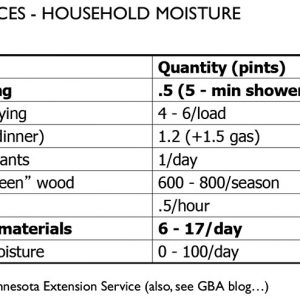 |
Related links:
- Preventing Moisture Problems in Bathrooms
- Houseplants need Humidity
- Venting a Bath Fan in a Cold Climate
Question 4: Can I remove my furnace chimney and replace it with a power vent?
James from Central New Jersey writes, Hi Guys. Really enjoy your podcast. I own an American Foursquare in central NJ and I’ve been slowly (VERY SLOWLY) replacing all of my roof slate around all four sides of my house. I currently have 3 sides done and was wondering what to do with chimney at the back. I love my house, but I hate the fact that it has the chimney running right through the middle. Part of my day job is making virtual reality (3-d) tours of new homes and I’ve noticed that all of the new homes have power vents for their hot water heaters and furnaces. Could this be a good option for me? I would really benefit greatly by removing my chimney. For one, I won’t have to build a cricket and flash it on the roof. I would gain larger attic space. I could gain space for shelving in my 2nd floor bathroom and most importantly allow me to open up my small kitchen. Really hoping you say this would be a great idea….and thanks
 |
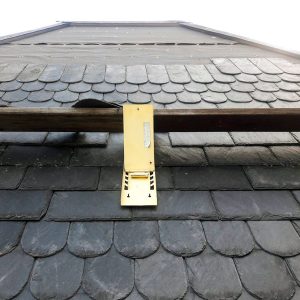 |
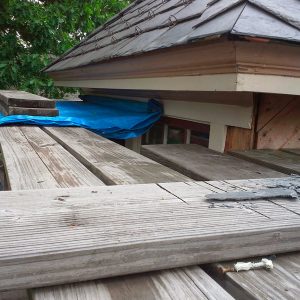 |
Related Links:
If you have any questions you would like us to dig into for a future show, shoot an email our way: [email protected].
If we use your question we’ll send you a FHB Podcast sticker!
 #KeepCraftAlive
#KeepCraftAlive
KeepCraftAlive hats help celebrate the value of true craftsmanship–plus 50% of all proceeds from every hat sold go to the #KeepCraftAlive Scholarship Fund, supported by Fine Homebuilding and SkillsUSA.
Buy a #KeepCraftAlive hat or t-shirt
This episode of the podcast is brought to you by MiTek
Brought to you by MiTek ProSeries Structural Wood Screws, the new standard in wood screws. MiTek’s ProSeries Screws are code compliant, reduce labor time, and are available for many fastening needs. And now the MiTek ProSeries line includes the WSTS Truss/Stud Screw. The WSTS includes an installation angle tool and driver bit to help you drive every screw at the exact angle needed without complicated jigs or measuring. Reverse thread angles on opposite ends of the screws provides higher load capacity while a fully threaded shank allows for more flexible installation. Get through the job faster, easier, and stronger with MiTek ProSeries WSTS Truss Stud Screw. Visit Mitek-Us.com and search Pro Series for more information.
Fine Homebuilding podcast listeners can now get 20% off anything in the Taunton store, including Renovation, now in its 5th edition. This home repair and remodeling bible describes in unvarnished detail best practice for hundreds of renovation projects. Also check out the Code Check series. These sturdy, spiral bound reference books will help you navigate the International Residential Code, The National Electric Code and the Universal Plumbing Code. Use the discount code FHBPODCAST to take advantage of this special offer.
We hope you will take advantage of a great offer for our podcast listeners: A special 20% off the discounted rate to subscribe to the Fine Homebuilding print magazine. That link goes to finehomebuilding.com/podoffer.
The show is driven by our listeners, so please subscribe and rate us on iTunes or Google Play, and if you have any questions you would like us to dig into for a future show, shoot an email our way: [email protected]. Also, be sure to follow Justin Fink and Fine Homebuilding on Instagram, and “like” the magazine on Facebook. Note that you can watch the show above, or on YouTube at the Fine Homebuilding YouTube Channel.
The Fine Homebuilding Podcast embodies Fine Homebuilding magazine’s commitment to the preservation of craftsmanship and the advancement of home performance in residential construction. The show is an informal but vigorous conversation about the techniques and principles that allow listeners to master their design and building challenges.
Other related links
-
- All FHB podcast show notes: FineHomebuilding.com/podcast.
- #KeepCraftAlive T-shirts and hats support scholarships for building trades students. So order some gear at KeepCraftAlive.org.
- The direct link to the online store is here.


